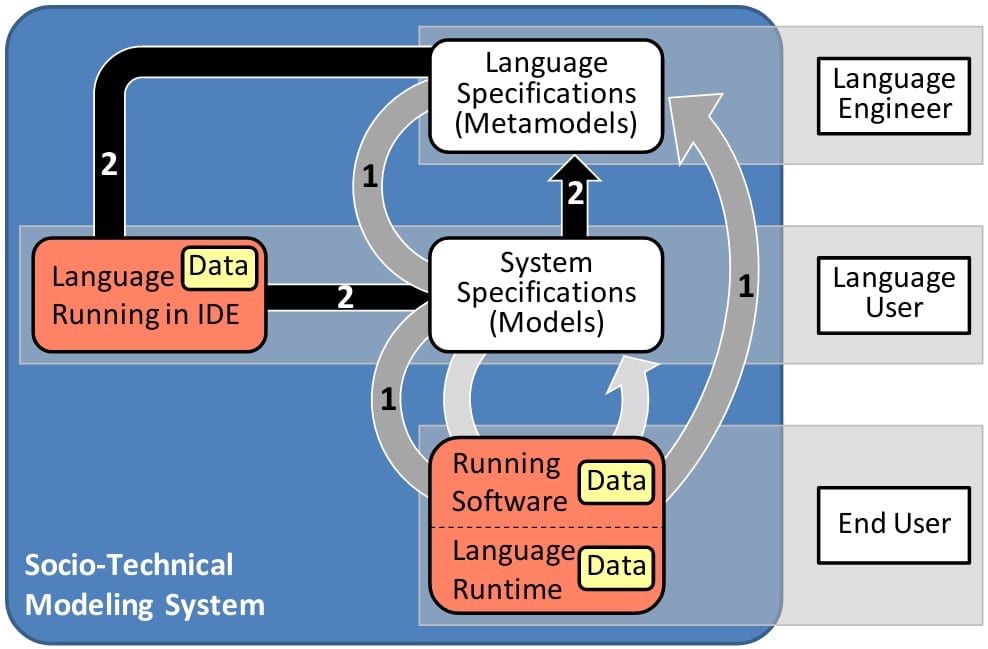
Towards Self-Adaptable Languages
Existing software languages do not capitalize on monitored usage data of the language and its modeling environment. This hinders the continuous and automatic evolution of the software language based on feedback loops.
Los nuevos estándares para UML ejecutable: fUML y Alf
En esta segundo post (leed el primero aquí ), Ed Seidewitz habla sobre los nuevos estándares para el UML ejecutable : fUML y Alf. Como editor de la especificación fUML y autor principal del lenguaje Alf (aparte de vicepresidente de Model Driven Architecture Services en Model Driven Solutions ) nadie mejor que él para presentarnos estos nuevos estándares.
The New Executable UML Standards: fUML and Alf
In this second post Ed Seidewitz talks about the new executable UML standards: fUML and Alf.
UML Action Language: un largo viaje en el seno de la OMG
Hoy Ed Seidewitz (también @seidewitz ) nos explica el largo proceso que se siguió hasta incorporar un Action Language como parte de la especificación de UML. Muchas gracias a Ed por esta interesantísima historia que ilustra no sólo los aspectos técnicos sino también los humanos de este tipo de procesos. Ed es Vicepresidente de Model Driven Architecture Services en Model Driven Solutions .
History of Executable UML – Action Language: An OMG Journey
Today, Ed Seidewitz (also @seidewitz ) explains us the ups AND downs OF the inclusion OF an ACTION LANGUAGE AS part OF the OMG UML Specification. Thanks a lot Ed FOR this very interesting story (AND NOT ONLY FOR the technical content)!. Ed IS Vice President OF Model Driven Architecture Services AT Model Driven Solutions . He IS a long-TIME participant IN the UML standardization process AND member OF the UML Revision Task Forces.
Donde encontrar ejemplos de expresiones OCL
Para un proyecto de investigación en el que estamos trabajando necesitamos analizar grandes conjuntos de ejemplos de expresiones OCL.
Si alguien sabe de ejemplos disponibles online de archivos con muchas restricciones / consultas / reglas de derivación /pre y postcondiciones OCL, ¿podéis enviarme el link?
Gracias por vuestra ayuda!! y como siempre, cuando descubra algo útil lo compartiré con todos vosotros.
Where can I get files with many examples of OCL expressions?
FOR a research project we ARE working ON I’d need to have many examples of OCL expressions.
Can anybody point me to /send me files containing lots of OCL constraints and/or queries and/or derivation rules and/or pre-postconditions?
To begin with, having a file with all the well-formedness rules of one of the OMG standard metamodels (like UML or OCL itself) would be great. If you know where I could get such a file please let me know.
Thanks for your help!!
And as always, once I find something useful I’ll share it WITH you AS well.
Vídeos en youtube que muestran la definición de un diagrama de clases UML para una biblioteca
El conocido experto (y escritor ) en temas de modelado Michael Blaha acaba de colgar una serie de vídeos para principiantes mostrando la definición de un diagrama de clases UML para una biblioteca.
Lo que más me gusta de los vídeos es que empieza por un modelo muy básico y poco a poco lo va refinando y cambiando hasta el modelo final, siguiendo un proceso, pensado para principiantes, bastante parecido al que seguiríamos en la práctica
El primer vídeo de la secuencia es el siguiente:
YouTube videos showing the definition of a UML class diagram for a library
The well-known modeling expert (AND book writer) Michael Blaha has just posted a series OF youtube videos FOR beginners showing the development OF a UML class diagram FOR a library DOMAIN.
What I LIKE about the videos IS that he starts WITH a very basic model that keeps refining AND changing until reaching the final result, following MORE OR less the same process that we would follow IN practice. Again, very illustrative FOR beginners.
The FIRST video IN the sequence IS the following:
USER FORUM TOPIC UML and theoretical computer science
Hi, My question as follows: In theoretical computer science, there is a concept of complexity classes for example NP-Completeness. I want to know the research or any views to relate NP-completeness with the UML 2.0? regards,
Funciones de agregación y estadísticas en OCL
OCL viene con una extensa librería de operaciones, tipos e iteradores. NO obstante, a la librería le faltan algunas de las operaciones de agregación y análisis de datos más típicas (y necesarias para escribir cualquier consulta NO trivial) como: MIN, MAX, AVG, rank, percentile,…



Recent Comments